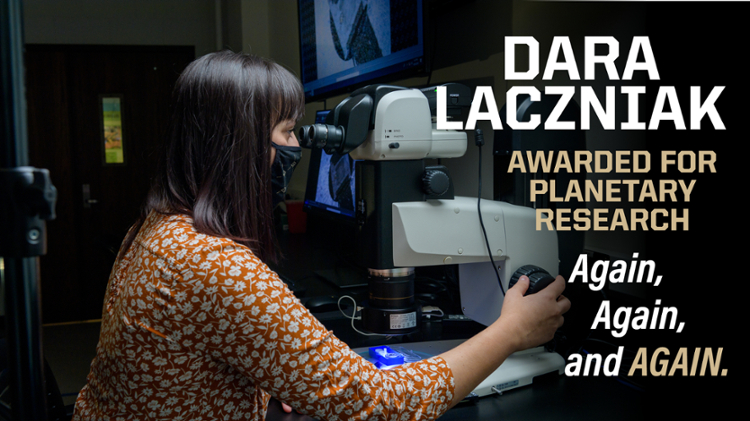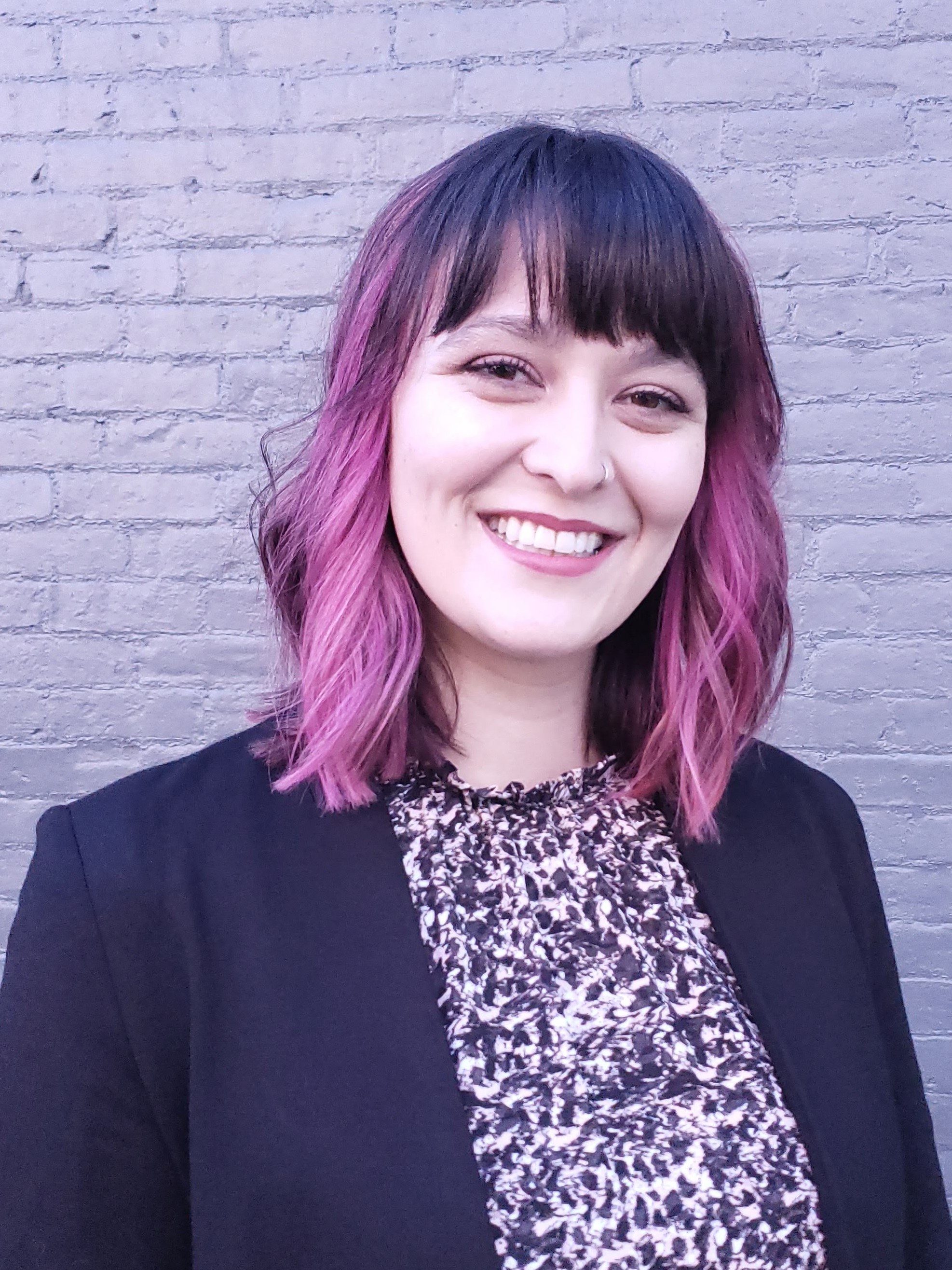EAPS graduate student Dara Laczniak receives multiple awards for planetary science research
11-10-2021

Dara Laczniak, a fourth-year PhD candidate in planetary science, had an award-winning summer. She received a 2021 Amelia Earhart Fellowship from Zonta International, a 2021 NASA FINESST Fellowship, and the Meteoritical Society’s 2021 Wiley Award that recognizes outstanding graduate student talks at the annual Meteoritical Society Meeting. Laczniak’s current research focuses on understanding how space weathering changes the microstructure, chemistry, and spectral properties of asteroidal surfaces. But, what exactly is space weathering? Contrary to popular belief, outer space is not completely empty; it’s a forbidding place full of damaging dust particles, ions, electromagnetic radiation, and more. Earth’s surface is protected from this harsh environment thanks to its thick atmosphere, but other planetary bodies—those that lack atmospheres—are not so lucky. Left unprotected and exposed, the surfaces of airless bodies, like the Moon and asteroids, are continuously altered by natural processes that occur in outer space. Space weathering is the collective term for these alternation phenomena. Laczniak’s work deciphering the effects of these phenomena gained attention this past year, earning her these three prestigious awards.

“I am so incredibly grateful to have received the Amelia Earhart and NASA FINESST fellowships, and I want to thank both Zonta International and NASA for these recognitions,” says Laczniak. “Not only do these awards provide me with the financial support to pursue my research, but they’ve given me confidence in my own research abilities and have assured me that I’m on the right track towards becoming a science leader. It is an honor to be categorized with this group of intelligent and talented 2021 Amelia Earhart and FINESST fellows who will be the scientific minds of the future. And it’s extremely special to be given an award that celebrates strong female leadership and commemorates one of the greatest STEM pioneers—Amelia Earhart.”
The Future Investigators in NASA Earth and Space Science and Technology (FINESST) Program provides research grants to graduate students who are designing and performing research projects relevant to interests of the NASA Science Mission Directorate (SMD). Laczniak and fellow EAPS graduate student Qin Jiang were both awarded FINESST Fellowships for 2021. If a student is considering applying for a FINESST Fellowship, she has some advice. She says the best sources of information are the FINESST NSPIRES webpage and networking with professors and graduate students. Furthermore, she says, “there are many components to the FINESST application, so it’s very helpful to read (and re-read) the solicitation found on the NSPIRES webpage that details both formatting and content requirements for the proposal package. I also highly recommend partnering up with other graduate students to peer review each other’s personal and research statements. A fresh, outside perspective really helps enhance your writing, clarify your main points, and streamline your story.”
The Amelia Earhart Fellowship was established in 1938 in honor of famed pilot, Amelia Earhart. The international fellowship is awarded annually to up to 35 women pursuing Ph.D./doctoral degrees in aerospace engineering and space sciences. Laczniak and fellow EAPS graduate student Amanda Rudolph were awarded Amelia Earhart fellowships for 2021. The Amelia Earhart application is submitted completely online. Besides a resume and a few letters of recommendation, it requires a 500-word essay that describes, in general scientific terms, your research project and career goals. According to Laczniak, it is quite difficult to summarize an entire dissertation in 500 words or less. She reached out to her fellow graduate students for their input and constructive criticism as she made her way through each draft of her essay.
Laczniak’s award-winning research is focused on understanding the effects of space weathering on carbon-rich asteroids. “The planetary science community has a pretty good understanding of how space weathering alters silicate-rich asteroids and the lunar surface, but we know relatively little about the effects of space weathering on carbon-rich bodies,” she explains. “Carbon-rich asteroids are extremely special because they contain abundant water-bearing minerals and organic molecules. Over 4 billion years ago, carbon-rich asteroids could have delivered the raw ingredients necessary for life to evolve, including both water and organics, to Earth’s surface through impacts (one of many hypotheses for the origin of life). In 2020, the Japan Aerospace Exploration Agency’s Hayabusa2 mission, brought back the first-ever fragments from a carbon-rich asteroid (called Ryugu) to Earth. And NASA’s OSIRIS-REx mission will bring back samples from another carbon-rich asteroid, named Bennu, in 2023.”
These returned samples give scientists an opportunity to analyze material from a carbon-rich asteroid directly in the laboratory. However, to maximize the science gained from these samples, scientists must first understand how they’ve been altered by space weathering processes. Bombardment by solar wind ions, also called solar wind irradiation, is thought to be the dominant space weathering process affecting asteroid surfaces. The Sun releases streams of high-velocity, charged particles that consist mostly of hydrogen and helium. These ions travel at a speed of nearly 1 million miles per hour—that’s over 6000 times the wind speed of a category 5 hurricane. When these high energy particles impact the surface of an airless body, they change the composition and texture of its rocks and soils.
“To determine exactly how solar wind space weathering alters carbon-rich asteroid surfaces, I recreate this process in the lab by blasting carbon-rich meteorites with high energy hydrogen and helium particles,” says Laczniak. “I then use electron microscopes and complementary spectroscopic analytical techniques to identify the ways in which this simulated solar wind has changed the meteorite’s organic material and constituent minerals from their original state. My results suggest that space weathering on carbon-rich asteroids is much more complex compared to other types of asteroids in our solar system. This work will provide critical ground-truth for analyzing returned samples from the Hayabusa2 and OSIRIS-REx missions and will help scientists better interpret surface composition from mission remote sensing observations.”
Laczniak is originally from Las Vegas, NV and grew up studying theater before discovering planetary geology in college. (Fun fact: She used to want to be an actress on Broadway.) As an undergraduate, she attended the University of Nevada Las Vegas (UNLV) and, ultimately, received a bachelor’s of science in geology in December of 2016. The decision to go to graduate school isn’t always made during someone’s undergraduate studies. Some students, like Laczniak, take time after completing their undergraduate degree to decide whether or not graduate school is right for them and the career path they want to pursue. “After graduating from undergrad, I wasn’t ready to commit to graduate school yet, so I worked as a research assistant at UNLV for a while and then decided to do some post-baccalaureate internships, which I learned are difficult to find and even harder to get!,” she says. “Eventually, I ended up getting a NASA PGGURP (now called the SUPPR) internship at Louisiana State University and a DEVELOP internship at Jet Propulsion Laboratory. Together, these internships reaffirmed my desire to go to graduate school and helped me develop some great research skills along the way.”
Dr. Michelle Thompson of EAPS is Laczniak’s advisor. Advising-style and departmental culture were important considerations for Laczniak when choosing a graduate school. “When picking a graduate program, I really prioritized the advisor and departmental culture, and Purdue EAPS got high scores in both of these categories,” Laczniak says. “I really enjoyed Dr. Thompson’s energy and excitement and we got along well, which is important in an advisor-advisee relationship. Also, during the EAPS expo I really enjoyed the other current and prospective graduate students in the department. I could easily see myself becoming friends with them, and I’m sure glad I was right because having a supportive cohort means so much in graduate school. I’m so appreciative of my colleagues and advisor in EAPS. I wouldn’t be here without them!”
Now, Laczniak is starting to think about what comes next, after graduate school. She loves teaching and mentoring and wants a career in which she can both advance science and promote science education and communication. Professorship at a liberal arts college or science policy are both viable directions, although Laczniak isn’t counting out any job opportunities just yet. She’s spending her last couple years at Purdue reaching out to professionals in the field and potential postdoctoral advisors for help determining precisely the type of future career she wants. Her ultimate dream is to use her background in science and theater to develop a STEAM camp (STEM + the Arts) for middle school girls that integrates both the arts and physical sciences to promote problem solving and communication.
Writer: Cheryl Pierce